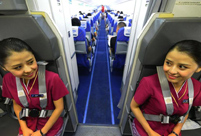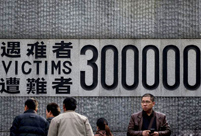 Maritime Silk Road Luxuries of the Han Dynasty
Maritime Silk Road Luxuries of the Han Dynasty
 Ceremony in honor of Confucius held in Sichuan
Ceremony in honor of Confucius held in Sichuan
 Hollywood blockbusters heats up fashion show in NW China
Hollywood blockbusters heats up fashion show in NW China
 Ciao! Chinese beauties!
Ciao! Chinese beauties!
 Naughty polar bear waves to photographer in Wapusk, Canada
Naughty polar bear waves to photographer in Wapusk, Canada
 An eye feast: BFA freshmen registration
An eye feast: BFA freshmen registration
 Top 10 most lavish weddings
Top 10 most lavish weddings
 Most amazing chi-pao beauties
Most amazing chi-pao beauties
 Observe the earth from space
Observe the earth from space
 Chinese lingerie brand arrives in Las Vegas
Chinese lingerie brand arrives in Las Vegas
The State Council Thursday announced new plans for the national college entrance examination, or gaokao. Under the new scheme, high school students will no longer be forced to choose whether to concentrate on either liberal arts or science. Enrollment rate will be raised in central and western areas as well as provinces with large populations. Special admission on the basis of talent in sports or arts is also revoked. Shanghai and Zhejiang Province have been selected as two pilot areas for the new approach, and it is expected to be implemented in the whole country in 2017.
This round of reform targets issues the public has been most concerned about in recent years. This is the most comprehensive reform since the country resumed the gaokaoin 1977. The two obvious aims are promoting social fairness and easing the pressure the gaokaobrings.
The public has hailed the move, but some scholars point out that more efforts need to be made to make sure that the reform achieves its intended objectives.
There is no doubt that the reform is a result of the public's sincere demand for reasonable systems.
Nonetheless, it is an indisputable fact that Chinese society is full of excessive competition, and no matter how we reform the gaokao, the pressure from social competition still exists. Society must have a fair evaluation on this.
The gaokaois a parameter of China's social fairness system. The public has high demands for it, while sometimes different groups have different demands. This makes it hard for any gaokaoreform to please everybody.
For example, this time more university places will be allocated to central and western areas as well as provinces with large populations. This is a process of redistributing benefits. New disputes may emerge as to how to redistribute these places.
In another example, stopping special admission on the basis of sports or art talent is vital to promote fairness, but then how to keep students interested in sports and arts will be a test for schools.
The dilemma surrounding the gaokaois typical in a huge society like China's. The problems appear to be a result of shortcomings in the gaokaosystem, but like many other policies that are well-designed in the making, the rules have been gradually compromised within the fiercely competitive gaokaosystem and by other social ills of the country. The new policy may face the same obstacles soon.
Despite the uncertainties, the gaokaoreform package released Thursday is refreshing. It declares China's determination to realize fairness in the higher education system.
Noticeably, the new reform plan has not divided society into two opposing camps that are morally challenging each other.
The difficulties of advancing gaokaoreform are frustrating, but at the same time the new gaokaopolicy brings precious hope and encouragement. It is hoped it will provide a pillar to unite the whole country.
 "Twin flowers" bloom in the air
"Twin flowers" bloom in the air China names 80 Anti-Japanese War memorial sites
China names 80 Anti-Japanese War memorial sites The 4th China-Eurasia Expo opens in Urumqi
The 4th China-Eurasia Expo opens in Urumqi Tall girls shine at model competition
Tall girls shine at model competition Girl who cannot gain weight: She is 1, 2.9 kilograms
Girl who cannot gain weight: She is 1, 2.9 kilograms Bazinga! Watch out the 'facekini' fashion bomb attack
Bazinga! Watch out the 'facekini' fashion bomb attack Experiencing maiden voyage between Sanya and Xisha
Experiencing maiden voyage between Sanya and Xisha Chinese inflatable aircraft meets public for the first time
Chinese inflatable aircraft meets public for the first time People enjoy delicacies in Tianjin undersea tunnel
People enjoy delicacies in Tianjin undersea tunnel COMAC jumbo jet and its global rivals
COMAC jumbo jet and its global rivals Capital Spirits: the capital's first liquor bar
Capital Spirits: the capital's first liquor bar Chengdu International Auto Show
Chengdu International Auto Show 2014 int’l drone exhibition
2014 int’l drone exhibition Trainings taken by Chinese navy divers
Trainings taken by Chinese navy divers Female PLA honor guards
Female PLA honor guardsDay|Week|Month